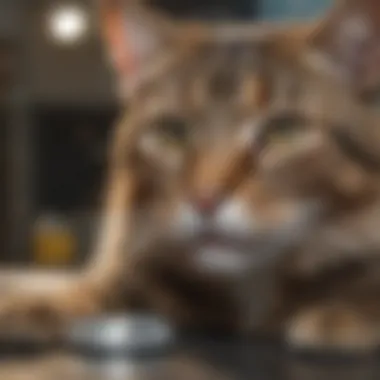Understanding the Cost of Annual Vet Visits for Cats


Intro
Caring for a cat involves numerous responsibilities, and annual veterinary visits comprise a significant part of these duties. Understanding the costs associated with these visits is crucial for cat owners. Beyond mere consultations, there are various elements that contribute to the financial aspects of feline health care. Budgeting for veterinary expenses ensures better health management for your pet and helps owners avoid unplanned financial strain.
In this article, we will delve into the specifics of the expenses incurred during annual vet visits. This knowledge can empower cat owners with the foresight needed to adequately prepare for their pets' health care requirements.
Pet Care and Grooming
Importance of Regular Care
Regular veterinary care is vital for a cat’s overall health. Annual check-ups allow professionals to spot issues before they become serious. These visits often include vaccinations, wellness checks, and consultations. Early detection can lead to better treatment outcomes, which may save money in long run.
Grooming Techniques by Pet Type
Grooming is not just about aesthetics; it impacts health too. Cats require different grooming methods based on their breed. For instance, long-haired breeds like Persians need frequent brushing to prevent matting. On the other hand, short-haired cats are generally easier to groom.
Tools and Products Recommendations
Investing in the right tools is essential for effective grooming. Some recommended products include:
- Slicker brush for long-haired cats.
- Comb for short-haired breeds.
- Nail clippers to maintain claw health.
- Ear cleaner for ear hygiene.
Using these tools correctly can enhance the grooming experience while promoting health.
Seasonal Care Tips
Each season presents unique challenges. For example, during winter, indoor humidity can impact skin health. In summer, increased grooming is necessary to manage shedding. Being aware of these changes can help owners better plan for their cat's grooming needs throughout the year.
Health and Nutrition
Understanding Pet Nutrition
Nutrition plays an integral role in a cat's well-being. Owners should understand key dietary requirements. Cats typically need proteins, fats, vitamins, and minerals from a balanced diet. Consulting with a vet regarding food choices should be a regular practice.
Common Health Issues by Species
Feline health issues vary commonly. Common conditions include obesity, dental problems, and diabetes. Awareness of these issues aids in understanding necessary vet services during annual visits.
Preventive Care and Regular Check-Ups
Preventive care includes vaccinations and regular check-ups. Vaccines protect against diseases that can be costly to treat. Regular check-ups allow for essential health monitoring and early intervention when necessary.
Food and Dietary Advice
Owners should pay attention to their cat's dietary habits. Feeding high-quality food and monitoring portion sizes is also significant. Consultation with a veterinarian on food formulations can provide valuable guidance tailored to each cat's needs.
Behavioral Training
Basics of Positive Reinforcement
Training cats can often be challenging, yet positive reinforcement can yield effective results. Offering treats for good behavior encourages learning.
Training Techniques Users Can Apply
Basic commands can be taught to enhance interaction. Techniques include using clickers and incorporating rewards during training sessions. Making training consistent can lead to the desired behavior changes.
Managing Behavioral Issues
Identifying and addressing behavioral problems can prevent future health issues. Consult with a veterinarian for severe cases, as they can provide more specialized advice tailored to the specific observations during a vet visit.
Importance of Socialization
Socialization is critical for cats, especially in their formative stages. Exposing them to various environments, sounds, and people can produce confident, well-adjusted pets.
Engaging Activities and Enrichment
Fun Games to Play with Your Pet
Engaging your cat through play fosters a strong bond. Games such as hide and seek or using toys that mimic hunting behavior can be enriching. These activities are also vital for physical health.
DIY Toys and Activities
Creating DIY toys can be cost-effective. Simple items like cardboard boxes can provide hours of entertainment. Imagination plays a crucial role in engaging the cat’s interests.
Importance of Mental Stimulation


Mental stimulation is just as important as physical activity. Interactive puzzles can challenge your cat's mind, leading to decreased boredom and destructive behavior.
Outdoor Adventures and Exploration
Controlled outdoor exploration can also be beneficial. Walks on a leash or supervised time in a catio connects your pet with nature without compromising safety.
Resources and Community Engagement
Recommended Books and Websites
Several resources offer more insights into cat care. Websites such as Wikipedia and Britannica provide valuable information. Additionally, cat care books can often give in-depth knowledge to pet owners.
Forums and Groups for Pet Owners
Networking with fellow cat owners can facilitate knowledge sharing. Websites like Reddit host various forums for discussing pet care topics in detail.
Finding Local Services and Classes
Finding reputable vets and classes in your area can enhance your cat's overall health management. Local directories can be useful for seeking these services.
Encouraging Community Sharing and Contributions
Collaboration within the community can lead to better practices in cat care. Sharing personal experiences fosters a network of support among cat owners.
The financial aspects of veterinary care can be daunting. Understanding these costs helps cat owners effectively plan for their pet’s health and well-being.
Prelude to Annual Veterinary Visits
Regular veterinary visits are fundamental for the health and well-being of your cat. These appointments serve multiple essential purposes, including preventive care, early detection of health issues, and the provision of vaccinations and treatments. Understanding the significance of these visits helps cat owners appreciate the costs associated with veterinary care. It enables them to plan financially, ensuring their pets receive timely and necessary medical attention.
Importance of Regular Veterinary Care
Regular veterinary care is crucial for maintaining a cat's health. It fosters a proactive approach, addressing potential issues before they escalate into serious health problems. Routine check-ups typically include a thorough physical examination. The vet assesses the cat's weight, coat condition, and overall demeanor.
Furthermore, through regular visits, various vaccinations can be given on schedule. These immunizations protect against severe diseases that could lead to long-term health complications or even death. In essence, the consistent engagement with a veterinarian builds a strong foundation for preventive health management.
Overview of Costs Associated with Vet Visits
Cost is an unavoidable aspect of caring for a cat, and annual veterinary visits contribute significantly to this. Cat owners should anticipate a variety of expenses that form the basis of the overall cost. An initial appointment may involve consultation fees, which cover the veterinarian's time and expertise, alongside examination fees.
Next are vaccination costs, which can vary based on the type of vaccines administered. Preventive treatments, like parasite control or dental cleanings, also add to the total expenditure. In addition, as cats grow older or develop health issues, diagnostic tests become more frequent, leading to further costs.
Therefore, understanding these expenses is vital. It equips pet owners with the knowledge to budget effectively and ensure that financial concerns do not compromise their cat's health and well-being.
Factors Influencing Veterinary Costs
Understanding the costs associated with annual veterinary visits for cats is essential for pet owners. Various factors contribute to these expenses, impacting how much one may spend annually. Knowing these elements can help cat owners plan better and be aware of what to expect financially when caring for their furry companions.
Type of Veterinary Practice
General vs.
Specialized Practices There are key differences between general and specialized veterinary practices. General practices handle routine health check-ups, vaccinations, and preventive care for cats. They are often more affordable and accessible. Specialized practices focus on specific health issues. They may offer advanced treatments for cats with complex problems. Choosing between these two can affect the overall cost.
A general practice is beneficial because it provides basic care efficiently. However, an owner's choice may depend on a cat's specific health needs. Specialized practices, while generally more expensive, can offer in-depth expertise for chronic conditions.
Location of Veterinary Clinic
Location plays a significant role in determining costs. Veterinary clinics in urban areas typically charge more than those in rural areas. This reflects higher operational costs and demand. Sometimes a city clinic may offer more advantages, such as access to advanced medical technology. However, rural clinics can provide more personalized service and lower prices.
When considering the location, pet owners should also factor in the convenience of travel and visit frequency. Shorter travel distances can often reduce overall costs, including time and fuel.
Age and Health Status of the Cat
Preventive vs.
Reactive Care Preventive care is essential in managing a cat's health. It allows for regular monitoring and early detection of issues. This type of care usually costs less in the long term compared to reactive care. Reactive care involves treatments that occur after a health issue has already developed.
Investing in preventive care can be a smart financial decision. Regular check-ups help avoid larger expenses associated with serious health problems that develop without warning. Routine vaccinations and health examinations can save cat owners significant money over time.
Chronic Conditions
Chronic conditions require ongoing medical attention and management. The costs associated with treating chronic illnesses are generally higher than those for healthy cats. Pets with diabetes, arthritis, or other long-term problems will need consistent care, including medications and specialized treatments.
Understanding these needs is critical. Owners should be prepared for the higher expenses that come with managing a chronic condition. Long-term financial planning is essential in these situations, as treatments can elevate annual veterinary costs.
Services Included in Annual Visits


Basic Health Examination
A basic health examination is a baseline service during annual veterinary visits. It includes a thorough check-up designed to assess a cat’s general health. This service is usually a fixed cost, but it is crucial for identifying potential problems.
The examination covers various aspects such as weight, heart rate, and dental health. Finding issues early can prevent costly treatments later. Regular assessments are a standard part of responsible pet ownership that can pay off financially in the long run.
Vaccinations
Vaccinations are essential for preventing serious diseases in cats. Most clinics offer vaccination packages that can be more affordable collectively than individual shots. Keeping a cat up to date on vaccinations is a critical expense that protects overall health.
While vaccinations can appear costly at first, they are an investment to prevent serious illnesses that would require far more costly treatments. Thus, this service remains one of the fundamental aspects of annual veterinary costs.
Diagnostic Tests
Diagnostic tests are part of a comprehensive health check during annual visits. These may include blood work or urinalysis to detect underlying health issues. While these tests incur additional costs, they provide valuable insights.
Being proactive with diagnostic tests can help in early detection of diseases, which is often less expensive than treating advanced conditions. However, this service carries different pricing levels depending on the specific tests required, which cat owners should be aware of when budgeting for their vet visits.
Breakdown of Typical Costs
Understanding the costs of annual vet visits is crucial for cat owners. Veterinary expenses can vary greatly, influenced by multiple factors. A detailed breakdown provides clarity on what to expect financially throughout the year. Therefore, grasping these costs allows for better budgeting and preparedness. It also emphasizes the significance of regular vet visits, illustrating how routine care can prevent more serious health issues and associated costs later.
Consultation Fees
Consultation fees represent the basic cost of visiting the veterinarian, covering the initial evaluation of the cat’s health. Typically, fees can vary depending on the practice, location, and experience of the veterinarian. In urban settings, fees may be higher compared to rural practices due to the cost of living and demand for veterinary services. Owners should anticipate spending anywhere from $50 to $100 for a standard appointment. Knowing this cost can help in planning the annual budget more accurately, ensuring that funds are available when necessary.
Vaccination Costs
Vaccination is essential for protecting cats from various diseases. Vaccination costs can depend on the type of vaccines required. Core vaccines, such as those for feline distemper, feline herpesvirus, and rabies, are foundational and often included in annual visits. Booster shots typically follow specific schedules, which may incur additional costs. Owners should be ready to budget between $20 and $75 per vaccine, including boosters. Vaccination may seem like a standard practice, but neglecting it can lead to severe health issues and higher treatment costs in the future.
Preventive Treatments
Preventive treatments are another key aspect of annual vet visits. They help mitigate potential health problems by addressing common issues before they escalate. These treatments often include parasite control and dental cleanings.
Parasite Control
Parasite control is focused on preventing infestations from fleas, ticks, and intestinal worms. Regular treatments are essential, especially in areas where these parasites are prevalent. The cost of parasite control varies based on the method used—topical treatments, oral medications, or collars. Prices typically range from $10 to $60 for each treatment. The key characteristic of these products lies in their effectiveness in safeguarding the cat's health. Regular parasite control not only contributes to the cat's well-being but also reduces the risk of these parasites spreading to the home or other pets.
Dental Cleanings
Dental cleanings play a critical role in maintaining a cat’s oral hygiene. Poor dental health can lead to serious health issues, including periodontal disease. The average cost for a dental cleaning can range from $100 to $300, depending on the veterinarian and any additional procedures. The unique feature of dental cleanings is the comprehensive approach to reducing bacteria and plaque buildup. Although the cost may seem high, investing in dental health can prevent more severe conditions that require expensive treatments later.
Laboratory and Diagnostic Fees
Laboratory and diagnostic fees are integral to diagnosing and monitoring a cat's health. These tests may include blood work, urine analysis, and other diagnostic procedures.
Blood Tests
Blood tests can offer crucial insights into a cat’s internal health. They help in early detection of diseases, which is invaluable for successful treatment. Typically, blood test costs range from $75 to $150. The primary characteristic of blood tests is their ability to provide essential health information swiftly. Thus, regular testing can assist veterinarians in altering treatment plans to improve long-term health.
Urinalysis
Urinalysis is another diagnostic tool frequently used to assess a cat’s urinary tract health. This test checks for signs of infection, crystals, or other abnormalities. Generally, the cost for urinalysis ranges from $30 to $75. The unique benefit of this test lies in its ability to identify issues early, which can prevent complications and reduce future medical expenses.
Cost of Medications
The cost of medications is another significant factor contributing to the overall expenses of veterinary care. This includes both prescribed medications for specific conditions and preventive medications.
Medications can be particularly costly for chronic conditions requiring ongoing treatment. The average monthly cost can vary widely, from $20 to over $100, depending on the required drug and dosage. Including this expense in the budget is essential for cat owners. Long-term health management through consistent medication can lead to better quality of life and may reduce the frequency of veterinary visits needed later.
Regional Variations in Costs
Understanding the cost of veterinary care requires a close look at the regional variations in pricing. These differences can greatly impact how much pet owners will ultimately pay for services. In the United States, cities often exhibit higher costs compared to rural areas. Factors such as living expenses, demand for veterinary services, and the availability of specialized care all contribute to this phenomenon.
Urban vs.
Rural Veterinary Practices
Urban veterinary clinics typically have higher overhead expenses. The costs of rent, utilities, and staff salaries are often elevated in metropolitan areas. This results in higher consultation fees and other associated costs. Additionally, urban areas may offer a higher density of specialized services. Specialized care can be more expensive due to the expertise required to perform advanced diagnostics or treatments.
In contrast, rural veterinary practices may operate with lower costs, leading to more affordable veterinary care. These clinics often have a closer relationship with their clients, which may foster a more personalized experience. However, rural areas might lack access to advanced medical services. Pet owners should consider these trade-offs when selecting a veterinary practice.
Regional Differences in Pricing
The cost of annual vet visits varies significantly by region. For example, the Northeast tends to have higher prices than the Midwest. This could be attributed to higher concentrations of pet ownership in urban centers, driving up demand and prices. Furthermore, states with higher living costs typically reflect these expenses in the cost of veterinary services.


Pet owners in areas with lower veterinary costs may find it easier to maintain preventive care routines. This could result in better health outcomes for their pets, leading to long-term savings. Conversely, those living in regions with elevated prices might face financial barriers to providing adequate care.
"Regional variations in veterinary costs highlight the importance of local factors, making it essential for pet owners to research and prepare for expenses accordingly."
As such, understanding these pricing dynamics is crucial for effective budgeting. Comparing costs across different regions can assist pet owners in making informed choices about their pets' healthcare needs.
Budgeting for Annual Vet Visits
Budgeting for annual vet visits is essential for every cat owner. It provides a clear framework for understanding the costs involved in maintaining your pet's health and preparing for unexpected expenses. By establishing a pet care budget, you can ensure that you have the necessary funds when veterinary issues arise. This planning can significantly reduce stress and help ensure that you are providing optimal care for your cat.
Creating a Pet Care Budget
Creating a pet care budget requires a realistic assessment of the known costs associated with veterinary care. Start by estimating the expenses that you can anticipate through regular vet visits. This includes:
- Consultation fees: These can vary among veterinary practices but having a rough estimate helps.
- Vaccination costs: Depending on your cat's age and needs, this can often include rabies, feline distemper, and other vaccines.
- Preventive care: Adding costs for flea and tick prevention, dental care, and routine tests is wise.
- Medical treatments: It's essential to factor in possible treatments for any chronic conditions your cat may have.
Consider adjusting this budget yearly as your cat ages or as health care needs change. Keep all receipts and references to past expenses as a foundation to refine your budget plan.
Establishing an Emergency Fund
Besides regular budgeting, establishing an emergency fund is crucial. The unexpected nature of pet health issues makes an emergency fund a practical safety net. Here are a few factors to consider when developing this fund:
- Set a goal amount: Determining a specific amount, often around $500 to $1,000, can give you a target to hit.
- Regular contributions: Treat this fund like any other bill, making consistent contributions each month.
- Accessing funds: Ensure that the money is easily accessible in case of emergencies but not too easy to dip into for non-emergent needs.
If you face a costly emergency, having a reserve can prevent you from making hasty decisions about your cat's health care. Ultimately, planning both a standard budget and an additional emergency fund nets peace of mind and ensures your feline receives appropriate care when needed.
Financial Assistance and Pet Insurance
Veterinary care is a significant investment for pet owners. Understanding options for financial assistance and pet insurance can greatly ease this burden. This section delves into these critical aspects, helping owners make informed decisions regarding their cat's health care costs.
Understanding Pet Insurance Options
Pet insurance helps alleviate the financial strain of unexpected veterinary expenses. Various plans exist, typically covering accidents, illnesses, and preventive care. Each policy differs in coverage limits, deductibles, and premiums.
When considering pet insurance, evaluate the following:
- Coverage Scope: Some policies cover all necessary treatments, while others might exclude pre-existing conditions.
- Reimbursement Rates: Most insurance plans operate on a reimbursement model. This means you pay the veterinarian upfront and submit a claim for reimbursement.
- Waiting Periods: After signing up for a plan, there often is a waiting period before coverage begins.
Researching various options is essential. One can find specific plans from providers such as Healthy Paws, Trupanion, and Embrace. Each offers distinct benefits and limitations.
Available Financial Assistance Programs
Financial assistance programs serve as a lifeline for many pet owners facing hefty veterinary bills. These options can significantly ease financial pressures.
Payment Plans
Payment plans allow owners to divide the total cost of care into manageable installments. This approach is particularly useful for higher expenses, such as surgeries or unexpected emergencies.
A key characteristic of payment plans is their flexibility, often allowing payment timelines that cater to individual situations. This makes them a popular choice among pet owners. Plans might have a nominal finance charge, but they are preferable to delaying necessary treatments due to cost concerns.
The unique feature of payment plans is that they help to maintain the health of cats without putting a strain on the owner's current finances. However, potential drawbacks may include the obligation to fulfill payment schedules or additional charges if payments are late.
Charitable Organizations
Charitable organizations provide financial support for pet owners unable to afford necessary veterinary care. These organizations often partner with veterinary clinics to assist in covering costs.
A prominent characteristic of these organizations is their mission-driven approach, focusing on alleviating the pain of pet ownership in times of financial strain. Such support can be especially beneficial for low-income families or those facing sudden emergencies.
The unique aspect of charitable organizations is that they often run on donations, making contributions essential to their existence. Therefore, while they are a valuable resource, availability may vary based on funding and demand. Owners should explore multiple organizations to find suitable assistance, such as The Pet Fund or RedRover.
Pro Tip: Always verify the legitimacy of any financial assistance program or charitable organization before applying for support.
In summary, understanding financial assistance and pet insurance options is crucial for cat owners. This knowledge empowers them to make better decisions, ensuring their pets receive adequate care without overwhelming financial stress.
The End
Summary of Key Points
In this article, we have extensively explored the intricate financial aspects of annual veterinary visits for cats. We discussed various costs that cat owners can anticipate, starting from consultations to vaccinations and preventive treatments. The discussion covered different regions, highlighting how urban and rural practices can significantly affect pricing.
It is crucial to understand that each factor influencing these costs often varies on a case-by-case basis. Elements such as the type of veterinary practice chosen and the specific health needs of the cat play integral roles in determining expenses. Being informed about these details aids in budgeting effectively.
To encapsulate, the major points include:
- Recognizing the necessity of regular veterinary care for overall cat health.
- Understanding the financial implications tied to various veterinary services.
- Variety in costs based on geographical locations and specific veterinary practices.
- The benefit of budgeting and planning for annual veterinary expenses.
Encouraging Proactive Health Management
Encouraging proactive health management is pivotal. Consistent veterinary care helps identify potential health issues before they become severe. Through regular visits, owners can ensure that vaccinations are up to date and preventive treatments are administered timely, providing the cat with a better chance of avoiding costly medical interventions later.
Pet insurance can also serve as a safety net, facilitating more relaxed decision-making when addressing health care needs. Moreover, engaging with veterinary professionals can guide owners on budgeting effectively, establishing emergency funds, and even exploring financial aid options when necessary.
Ultimately, the focus should not solely be on cost but also on the quality of care provided. Taking an active role in the health management of a cat not only enhances its quality of life but can also lead to significant long-term savings.















